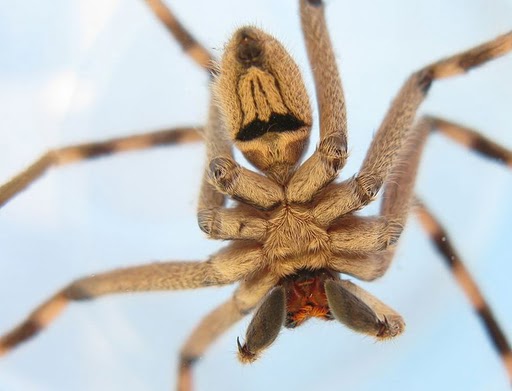The huntsman spider belongs to the Sparassidae family. All spiders in the Sparassidae family have eight eyes facing forward, arranged in two rows of four. This particular species of spider can grow to very large sizes.
One of the most common fears people have is the fear of spiders. Regardless of your personal opinion, spiders have a way of sending a slight shiver down even the bravest person’s spine. But what if there was a spider that truly lived up to the fear of arachnophobia?
The huntsman spider is truly a marvel of nature. However, before we delve into the different aspects of the spider itself, let’s take a quick look at a strange urban legend that revolves around it.

What Is The Legend Of The Huntsman Spider?
Urban legends can give us chills, but this particular urban legend originated from meme culture (yes, you read that correctly).
Someone discovered a huge huntsman spider in their relative’s house. They found the spider underneath a large wall clock. The spider appeared to be as big, if not bigger, than the clock, with its hairy legs peeking out from underneath. Hence, the spider earned the infamous nickname “clock spider”. The person ended up taking a photograph of the spider, as shown above.

Now, the legend – or more of a joke – is that the spider had a ninth leg. It supposedly lost its extra leg during a battle with a limecat (I, too, was expecting something more intriguing). The “legend” goes on to describe how this spider became a god and some other nonsensical details about worshipping it (purely a joke, I hope).
Well, enough of the silly nonsense, let’s dive into the scientific aspects of this fascinating spider.
Facts About The Huntsman Spider
Physical Appearance
The huntsman spider belongs to the Sparassidae family. All spiders in the Sparassidae family have eight forward-facing eyes, arranged in two rows of four. This particular species of spider can grow to very large sizes.
In Laos, the male huntsman spider can have a leg span of 25 to 30 cm. These spiders are often mistaken for tarantulas, but the key difference is that their legs are angular and extend forward like a crab.
 (Photo Credit : JonRichfield/Wikimedia Commons)
(Photo Credit : JonRichfield/Wikimedia Commons)
The upper surface of the huntsman spider has inconspicuous gray and brown tones, while the underside of the spider is colored black and white as a warning signal for potential predators.
Habitat
These spiders typically dwell under rocks, tree bark, and similar natural structures. In areas where humans live, the clock spider can be found in common sheds, garages, and occasionally in other distributed spaces. Their vision is excellent, allowing them to spot approaching humans and other large animals from a distance, giving them ample time to run away and hide. This is perhaps why we don’t often come across these spiders!
Interestingly, prior to gaining fame as the clock spider, the huntsman spider actually appeared in another popular culture form – Spiderman! Yes, the spider that bites Peter Parker and turns him into a superhero is none other than the social huntsman spider.
Huntsman spiders, like most spiders in the Sparassidae family, use venom to immobilize their prey. Their venom is not only used for hunting, but also serves as a defensive bite tactic. Unlike most spiders, huntsman spiders can bite humans and cause harm. While their fangs may not puncture human skin easily, their venom is potent enough to affect creatures larger than small beetles or worms.
However, not all huntsman spiders that bite pose a danger to humans. Many bites are painful and cause inflammation due to the size of the fangs, but there is one particular huntsman spider in Australia, known as Neosparassus, that has neurologically potent venom. These spiders start off green in color and turn brown as they molt. Although their bites can cause symptoms such as nausea, headaches, and vomiting, such symptoms are rare.
In terms of mating rituals, the male Heteropoda venatoria is a huntsman spider species found worldwide. Recent studies have revealed that these spiders deliberately create a substrate-borne sound when they detect a chemical left behind by a female of the same species. The males then follow the trail of pheromones to find the females. Once located, the males anchor themselves to the ground and use their legs to transmit vibrations from their bodies to the surface they are in contact with.
Most of the sound emitted during this mating ritual is produced by strong vibrations from the abdomen. Each male has a unique vibration frequency, which helps females distinguish between different males competing for their attention. The typical pattern of these vibrations consists of short bursts of intense vibrations.
If a female is interested in mating, she follows the vibrations to the source where the male is waiting to copulate with her. To humans, these sounds are often heard as rhythmic ticking, similar to a quartz clock that fades in and out. However, these mating “calls” can only be heard in relatively quiet environments.
So the next time you hear about the legend of the clock spider, you can shed some light on the truth instead of perpetuating the myth!
